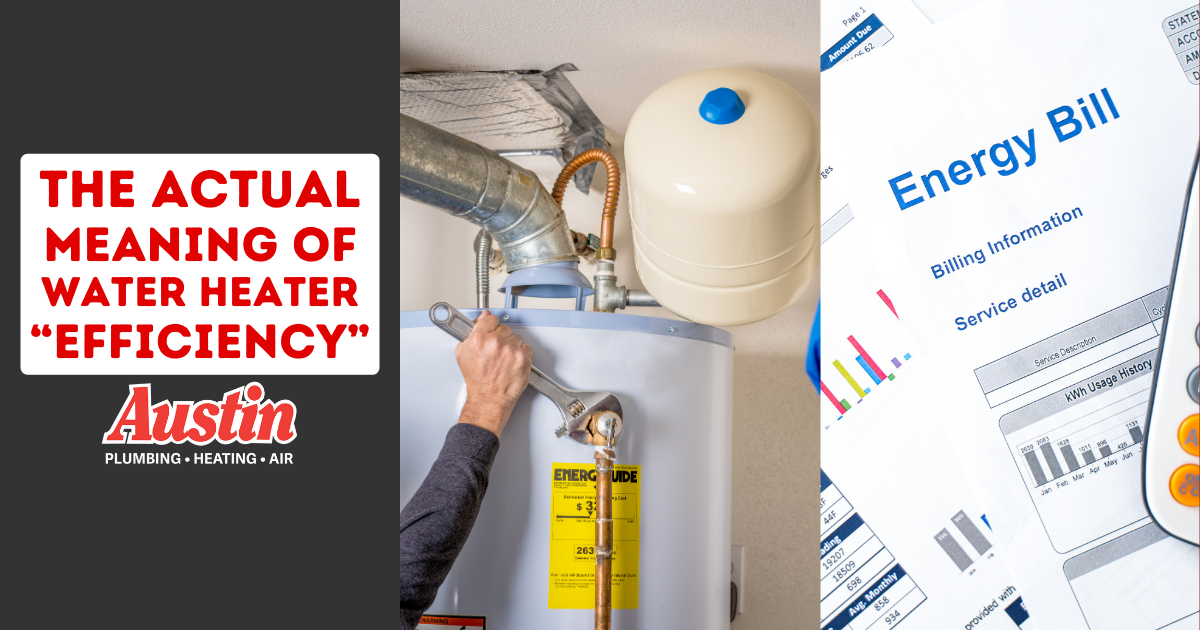Water Heater Efficiency: Explained (Energy Use vs. Water Heating Ability)

The Wisconsin Master Tradesman’s guide to understanding efficiency-what it means and what it doesn’t-in a water heater.
A lot goes into calculating efficiency in a water heater. At the same time, there is a limit to what its Uniform Energy Factor (UEF) can tell you. So, what exactly makes a water heater “efficient”?
First, it’s important to recognize that efficiency is not the same as efficacy. In other words, an “efficient” water heater is not the same as an “effective” water heater. UEF ratings are just an expression of hot water generated as a function of energy input. So if the appliance ranks high in UEF, that simply means it’s relatively energy-efficient. It may still be slower, costlier, or less convenient to the end user (that’s you).
How Energy is Used in Different Types of Water Heaters
Gas water heaters work by converting chemical energy (fuel) to thermal energy (heat) in a process called combustion. In theory, every dollar you spend on fuel should yield a dollar’s worth of hot water-right?
In reality, it doesn’t work out so cleanly: combustion produces not only heat, but also exhaust.
Tank-Style Gas Heaters
In a gas tank water heater, only 60 to 70 percent of the heat generated gets absorbed by the water in the tank. The remaining 30-40% is lost. Where does it go? Look no farther than the exhaust piping. Exhaust exits the vent pipes in the form of exhaust, and the vent pipes themselves become extremely hot (which is why you should never touch them).
Similarly, one dollar spent on natural gas for combustion only results in about 60 to 70 cents’ worth of hot water. About $0.30 is wasted for every dollar spent to fuel a standard gas water heater. That heat loss is ultimately the reason why gas heaters are considered less efficient than electric heaters.
Tankless Gas Water Heaters
Tankless water heaters, even if they’re still fueled by natural gas, hold onto exhaust a little longer in order to allow more heat absorption. (Don’t worry-there is no exhaust mixed in your water; only the heat energy is transferred). If you just go tankless, you can achieve an efficiency between 85% and 96% without switching from gas to electric. To be clear, that’s about 85 to 96 cents on the dollar, which is already far more efficient.
Electric Water Heaters
Then you have electric water heaters. Both tank-style and tankless models, as long as they’re powered by electricity, reduce energy loss to less than 1%. In terms of hot water production, electric power gets you more than 99 cents on the dollar.
In short, yes, upgrading to an electric heater can make a sizable difference in efficiency…if you’re converting from a tank-style gas heater. If you’re converting from tankless gas, there’s still a difference, but a minor one.
Strictly speaking, electricity is a secondary energy source (usually derived from burning fossil fuels like coal). That’s why electricity per se cannot be called renewable, sustainable, or clean. That’s not to say that it’s non-renewable, unsustainable, or dirty. It simply means that electric water heaters have still got a lot to prove before the efficiency war is won.
Let’s look at some additional ways to compare efficiency. We have a feeling you may not have considered all of these before.
How much energy is my water heater actually using when it’s on?
Tank gas heaters consume a lot of energy while on-and they spend a lot of time on!
- A gas-powered, tank-style water heater has two modes: on and off. There is no in-between. When the internal thermostat detects the minimum allowed temperature, the burner kicks on automatically and works as hard as it can until the temperature reaches a predetermined maximum.
- The BTU or British Thermal Unit is a measure of heat energy emitted. As long as it’s on, a tank gas water heater can burn between 40,000 and 75,000 BTU depending on tank size and, in turn, burner size. (Larger tanks require bigger burners in order to heat larger quantities of water at a reasonable speed.)
- The tank heater doesn’t discriminate by demand, either. Whether you need a cup of water for tea or multiple gallons for a shower, once you turn the heater on, it stays that way until the tank is completely full of hot water. You can’t say, “That’s enough for now, Siri!” The tank heater doesn’t hear you. It’s not going to stop burning gas until it has fully heated an entire tank’s worth of water again. Keep in mind this could mean anywhere from 10 to 30 minutes of combustion at 40-75k BTU, and you are quite literally paying for it.
Tankless gas technology delivers a good experience with less waste.
- The tankless gas model has a variable-capacity burner. In other words, while it’s on, it’s only burning enough gas to meet your immediate demand for hot water. If you run it for a few seconds to make a cup of hot chocolate, it will actually turn itself off as soon as you close the faucet. Once again, this is already a huge improvement over its predecessor, regardless of fuel source!
Electric water heaters sacrifice some quality of life in exchange for ultimate efficiency.
- Electrical energy is efficient in that it transfers heat energy with little to no waste. However, to accomplish the task of heating water, electric water heaters require a lot more energy than gas water heaters do. Put simply, you’re using a lot of electricity instead of a little gas-but you’re only wasting a little electricity, rather than wasting a lot of gas.
- Electric models also take much longer than gas models to heat the same quantity of water. Tank-style electrics, in particular, recover at the slow rate of 20 gallons per hour regardless of tank size. So their recovery period (read: how much time you have to wait for hot water) can be depressingly long.
How much fuel does your water heater use when you’re NOT using hot water?
Standard-venting, tank-style water heaters, whether gas or electric, have one thing in common. That is the constant consumption of energy to maintain a set temperature in the tank. If they’re gas-powered, they’re burning fuel continuously; if they’re electric, they’re using electricity continuously. This occurs even when the appliance is not in use!
Standing pilots, which are small reserves of gas that burn 24/7, can still be seen even in some modern iterations of the tank-style design. These exacerbate not only the problem of energy use but also the cost of ownership.
This is where tankless or “instantaneous” water heaters shine. They don’t consume fuel when there is no demand for hot water. They don’t use pilots, either. All in all, they tend to be highly efficient when compared with tank water heaters, regardless of fuel type.
Air Infiltration (Don’t shoot yourself in the foot!)
This section applies only to gas water heaters. If yours is electric, feel free to skip ahead.
-
- The process of combustion requires three reagents to begin: oxygen, gas, and heat. What’s nice is that once the chemical reaction has started, it will continue to produce its own heat energy. Obviously, the same cannot be said for air or natural gas. Thus, all gas water heaters need both a fuel source and a source of incoming air.
- Most water heaters in Wisconsin (all standard-vent, as well as some power-vent) take air from inside the building envelope. When combined with the gas and heat inside the appliance, that air becomes part of the exhaust that ends up back outside. But that’s air that you already paid to heat or cool. Now, it’s not warming or cooling your home, but instead being shot up through the chimney. In that regard, it represents a double loss: not only does the water heater generate some waste of its own, but you’re also wasting conditioned air that your HVAC system worked hard to create.
- When you pull air out of the home for combustion, the space left behind is already filling back in with new air. (Needless to say water heaters don’t create spacetime vacuums, or your house would crinkle like a soda can instantaneously.) Another way of thinking about it: as more room is created, more air is able to fill in the space left behind from the combustion process. Now, from where does your water heater get this new air supply? Outside air seeps into the home through cracks, windows, and doors in a process called infiltration. That air is then reheated as the cycle begins anew.
- You may not see the negative effects of infiltration on your water heating bill, but it’s likely to make its presence known on your heating and air conditioning bill.
- Water heaters that draw outside air in for combustion, rather than drawing from the home’s interior and letting it fill back up, have the smallest infiltrative effect. Tankless water heaters are the most common variety that do this.
Your chimney is working even when your water heater isn’t!
Hot air rises. If your water heater is connected to a chimney, then that chimney is pulling warm, conditioned air out of your home as long as the inside of your house is even a little bit warmer than outdoors.
- This always incurs some infiltration. However, converting to a tankless water heater OR converting to one that vents directly outside (power venting) can eliminate the unwanted heat loss and negate the infiltration from the chimney effect.
- This point is not directly related to efficiency, but you may find it beneficial to think about: many professional roofers recommend eliminating chimneys and other roof penetrations. This is mainly because it reduces the chance for roof leaks, but incidentally, that also makes a difference for your water heater! So, when replacing a roof, many homeowners in Wisconsin also find it reasonable to replace their old, chimney-vented water heater with something more efficient to eliminate both penetration (water) and infiltration (air).
To Efficiency and Beyond
As with everything, there’s more to efficiency than meets the eye. Austin Plumbing, Heating & Air bases our water heater recommendations around multiple factors, including efficiency-as well as your needs, wants, and budget. You have a lot of options! For a thorough explanation and evaluation of them all, just give us a call at (262) 367-3808 today.





